Ford Fusion
Front Brake Pads Replacement Guide
How to replace the front disc brake pads
on a 2006 to 2012 Ford Fusion sedan with picture illustrated instructions.
By Paul B. Michaels Author & Photographer Auto Mechanic Since 1989 |
||
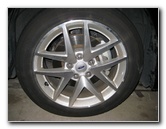 Ford Fusion Front Wheel |
 Loosen Five Lug Nuts |
 Raise Vehicle |
| This
automotive "how-to" guide was specifically written to assist owners
of the 2006, 2007, 2008, 2009, 2010, 2011 and 2012 Ford Fusion sedan in replacing the front brake
pads. Owners of other related vehicles such as the Ford Edge, Mondeo, Fiesta, Focus, Taurus, Escape, Flex, Lincoln MKX, MKZ, Zephyr, Mazda CX-9, Mazda6 and Mercury Milan may also find this DIY guide to be helpful. The tools needed to complete this front brake job include a floor jack, jack stands, a lug nut wrench, a 14mm socket with ratcheting wrench, a "C" or "F" clamp, and pliers or a spanner wrench. |
||
|
|
||
A few aftermarket front brake pads compatible with the '06-'12 Fusion include the following with their respective part numbers: Wagner ThermoQuiet QC1164, Bosch BC1164 QuietCast, ACDelco 17D1164CH, Bendix D1164, Akebono ACT1164, Monroe CX1164, Raybestos PGD1164C, Centric 105.1164, and Motorcraft BR1164B. |
||
 Spin Off Lug Nuts |
 Lug Nuts Removed |
 Brake Caliper & Rotor |
| The first few steps
are to engage the emergency parking brake, chock the rear wheels, and
slightly loosen the five lug nuts on the front wheels with a tire iron. Then raise the front of the vehicle with a floor jack and securely support it with jack stands. Spin the lug nuts off the rest of the way and pull off the front wheel. Behind the wheel, you'll find the front brake caliper, caliper bracket, brake rotor and pads. |
||
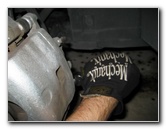 Loosen Lower Caliper Bolt |
 Pliers Holding Caliper Pin |
 Caliper Bolt Removed |
| Use a 14mm socket
and ratcheting wrench to remove the lower caliper bolt by turning it
clockwise.
If you have trouble removing the caliper bolt, use a pair of pliers or a spanner wrench to prevent the caliper pin from moving while turning the bolt. |
||
 Lift Up Brake Caliper |
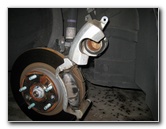 Swing Caliper Off Pads |
 Secure Caliper With Twine |
| With the lower
caliper bolt removed, you can swing the caliper upwards and off the brake
pads.
Use some sturdy twine or rope to secure the brake caliper to the shock tower to prevent it from crashing down on your fingers while replacing the pads. |
||
 Remove Springs |
 Brake Pad Springs |
 Pull Off Old Brake Pads |
| Remove the brake
pad springs and set them aside in a safe place.
Then pull the old brake pads out of the caliper bracket while making a mental note of how the wear or "squeal" bar is orientated. I always buy the Wagner ThermoQuiet QC1164 brake pads since they have excellent reviews on Amazon. I also love how they don't have any backing plates or shims and don't require any disc brake quiet gel like some other brands. |
||
 Brake Pads Removed |
 Brake Parts Cleaner Spray |
 Disc Brake Quiet Gel |
| Use some brake parts cleaner spray and a shop
rag to thoroughly clean the brake rotor, caliper and bracket.
To help prevent braking noise, an optional step is to apply some CRC "Disc Brake Quiet" gel or a similar product to the rear of the brake pads where they come in contact with the caliper. Do not apply anything to the friction surface of the new pads.
The torque specification in the service manual for tightening the bracket bolts is 66 lb-ft. |
||
|
|
||
 Caliper Pin Rubber Boot |
 Pull Out Lower Caliper Pin |
 Lubricate Caliper Slider Pins |
| Carefully pull out
the lower caliper pin from the rubber dust boot and check that it is
adequately lubricated.
If it looks dry, apply a generous amount of high pressure moly grease or a silicone based brake caliper grease. Also be sure to later remove and lubricate the upper caliper pin as well. |
||
 Brake Fluid Reservoir |
 Remove Brake Fluid Cap |
 Brake Caliper Piston |
| Move to the engine
bay and remove the brake fluid reservoir cap in preparation for compressing
the brake caliper piston with a "C" or
"F" clamp.
This will allow the brake fluid to more easily travel backwards through the system. |
||
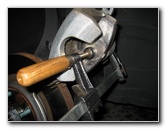 Compress With "F" Clamp |
 Old Anti-Rattle Clips |
 Install New Brake Pads |
| In order for the
brake caliper to fit over the thicker new brake pads, the piston will need
to be pushed backwards by compressing it with the "F" clamp.
Use the back of an old brake pad to help evenly apply the pressure from the "F" clamp while very slowly compressing the piston. Regularly check the level of the brake fluid in the reservoir while compressing the piston to avoid having it overflow. If your new front brake pads came with new metal anti-rattle clips, remove the old ones before installing the new clips. Then insert the new brake pads into the caliper bracket with the wear or "squeal" bar orientated in the correct position. |
||
 Replace Pad Springs |
 Lower Caliper Over Pads |
 Insert Caliper Bolt |
| Push the two brake
pads flush against the rotor and re-install the metal springs.
Carefully cut the twine supporting the caliper and lower it down over the new brake pads. If it won't fit over the new brake pads, compress the caliper piston a bit more with the "F" clamp. |
||
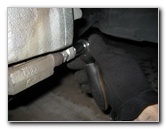 Tighten With 14mm Socket |
 Hold Caliper Pin With Pliers |
 Brake Fluid Bleeder Valve |
| Tighten the lower
caliper bolt by turning it in the counterclockwise direction (as seen from
the outside of the car) to just past hand tight or about 20 lb-ft of torque.
The torque specification in the service manual for tightening the 14mm caliper bolts is 19 lb-ft. Double check that both caliper bolts are tight before continuing. If your brake pedal previously felt mushy or spongy, the brake fluid may be contaminated with water or the brake lines may contain air bubbles. It would be best to bleed the brake lines at this time in order to flush out the old fluid and replace it with new DOT3 brake fluid. For more on this topic, check out my Brake Line Fluid Bleeding DIY Guide. |
||
 |
 Spin On Lug Nuts |
 Lower Vehicle |
| Replace the front
wheel and spin on the five lug nuts by hand to prevent cross threading them.
Tighten the five lug nuts a bit with the tire iron. Then lower the vehicle from the jack stands and floor jack. |
||
 Tighten Lug Nuts |
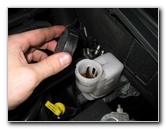 Check Brake Fluid Level |
 Replace Brake Fluid Cap |
| Continue
progressively tightening the lug nuts in a criss cross or star patten to
just past hand tight. It would be best to use a torque wrench or an air gun
with a torque stick to tighten the lug nuts to about 100 ft lbs. Please check your owner's manual. The lug nut torque specification for this 2010 Ford Fusion is 100 lb-ft. Sit in the driver's seat of the vehicle and pump the brake pedal a few times to restore the brake line pressure. Then check the brake fluid level in the reservoir and verify that it is at the "MAX" (maximum) line. If necessary, pour in some fresh DOT 3 brake fluid. Once the brake fluid level is correct, replace the brake fluid reservoir cap by twisting it on clockwise. To break in your new brake pads, just drive normally for the first few hundred miles while trying to avoid any hard or "panic" stops which may glaze the new brake pads and cause them to be noisy and not stop as well. It's also a good idea to regularly examine your driveway for drops of brake fluid which may indicate a leak, check the brake fluid level in the reservoir, and also check that the lug nuts are still properly tightened. For more,
please check out my
Ford Fusion Repair & Maintenance Guides page. |
||
| If you found this guide to be helpful,
please consider making a small donation by clicking on the PayPal.com
"Donate" button located to the right of this paragraph. Thank you!
(Note: I am not a registered charity. Donations are not tax deductible.) |

